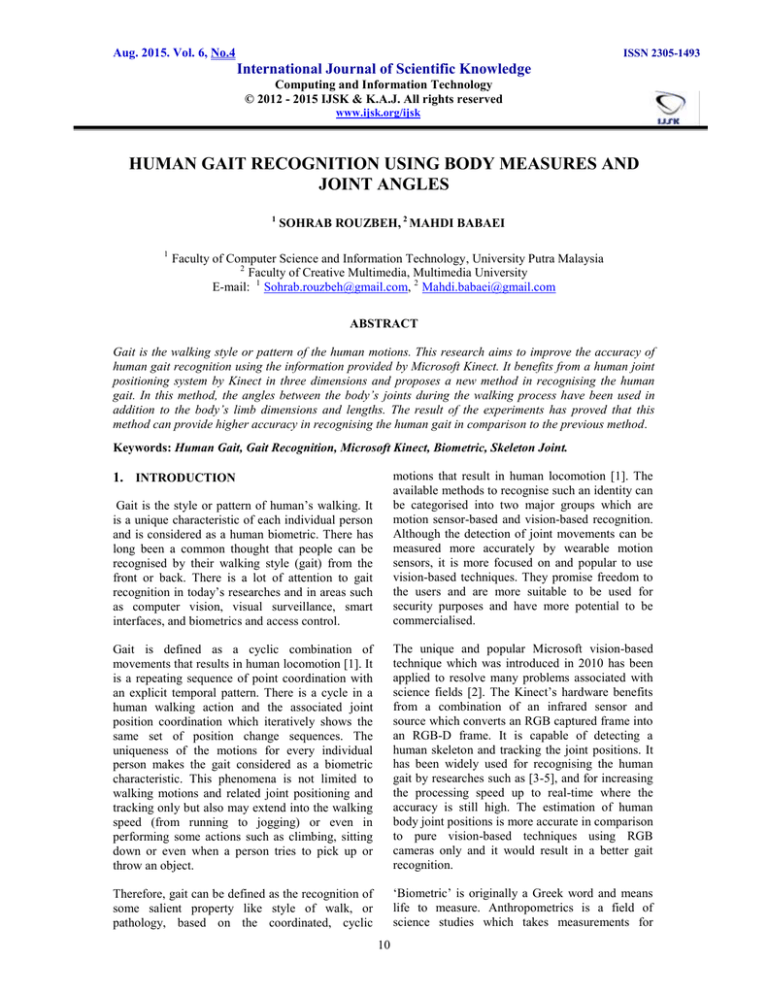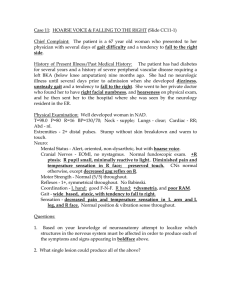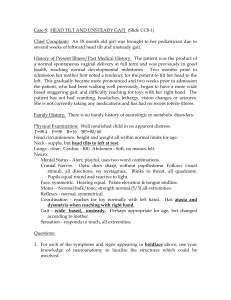
Aug. 2015. Vol. 6, No.4
ISSN 2305-1493
International Journal of Scientific Knowledge
Computing and Information Technology
© 2012 - 2015 IJSK & K.A.J. All rights reserved
www.ijsk.org/ijsk
HUMAN GAIT RECOGNITION USING BODY MEASURES AND
JOINT ANGLES
1
1
SOHRAB ROUZBEH, 2 MAHDI BABAEI
Faculty of Computer Science and Information Technology, University Putra Malaysia
2
Faculty of Creative Multimedia, Multimedia University
E-mail: 1 Sohrab.rouzbeh@gmail.com, 2 Mahdi.babaei@gmail.com
ABSTRACT
Gait is the walking style or pattern of the human motions. This research aims to improve the accuracy of
human gait recognition using the information provided by Microsoft Kinect. It benefits from a human joint
positioning system by Kinect in three dimensions and proposes a new method in recognising the human
gait. In this method, the angles between the body’s joints during the walking process have been used in
addition to the body’s limb dimensions and lengths. The result of the experiments has proved that this
method can provide higher accuracy in recognising the human gait in comparison to the previous method.
Keywords: Human Gait, Gait Recognition, Microsoft Kinect, Biometric, Skeleton Joint.
Gait is the style or pattern of human‟s walking. It
is a unique characteristic of each individual person
and is considered as a human biometric. There has
long been a common thought that people can be
recognised by their walking style (gait) from the
front or back. There is a lot of attention to gait
recognition in today‟s researches and in areas such
as computer vision, visual surveillance, smart
interfaces, and biometrics and access control.
motions that result in human locomotion [1]. The
available methods to recognise such an identity can
be categorised into two major groups which are
motion sensor-based and vision-based recognition.
Although the detection of joint movements can be
measured more accurately by wearable motion
sensors, it is more focused on and popular to use
vision-based techniques. They promise freedom to
the users and are more suitable to be used for
security purposes and have more potential to be
commercialised.
Gait is defined as a cyclic combination of
movements that results in human locomotion [1]. It
is a repeating sequence of point coordination with
an explicit temporal pattern. There is a cycle in a
human walking action and the associated joint
position coordination which iteratively shows the
same set of position change sequences. The
uniqueness of the motions for every individual
person makes the gait considered as a biometric
characteristic. This phenomena is not limited to
walking motions and related joint positioning and
tracking only but also may extend into the walking
speed (from running to jogging) or even in
performing some actions such as climbing, sitting
down or even when a person tries to pick up or
throw an object.
The unique and popular Microsoft vision-based
technique which was introduced in 2010 has been
applied to resolve many problems associated with
science fields [2]. The Kinect‟s hardware benefits
from a combination of an infrared sensor and
source which converts an RGB captured frame into
an RGB-D frame. It is capable of detecting a
human skeleton and tracking the joint positions. It
has been widely used for recognising the human
gait by researches such as [3-5], and for increasing
the processing speed up to real-time where the
accuracy is still high. The estimation of human
body joint positions is more accurate in comparison
to pure vision-based techniques using RGB
cameras only and it would result in a better gait
recognition.
Therefore, gait can be defined as the recognition of
some salient property like style of walk, or
pathology, based on the coordinated, cyclic
„Biometric‟ is originally a Greek word and means
life to measure. Anthropometrics is a field of
science studies which takes measurements for
1. INTRODUCTION
10
Aug. 2015. Vol. 6, No.4
ISSN 2305-1493
International Journal of Scientific Knowledge
Computing and Information Technology
© 2012 - 2015 IJSK & K.A.J. All rights reserved
www.ijsk.org/ijsk
humans [6]. It includes fingerprints, voice patterns,
Iris and hand measurements and as a recent trend,
the human gait. These unique characteristics have
been used for security purposes mainly because
they are unique and always accessible. They cannot
simply change, be stolen or hacked.
participants. This study has been based fully on
objective measuring of the accuracy by monitoring
the ratio of success and failure by the system
administrator during the experiment.
The advantage of gait over other human biometrics
is that it does not need the user‟s cooperation for
monitoring purposes unlike the opposite side with
the other biometrics which require a conscious
interaction between humans and the computer. This
technology would be used in banks, airports or
even other public places.
A general view of the gait recognition technique
consists of two feature extraction steps and the
comparison of the results to the database of gait
data [7]. The gait information can be extracted
even using very poor capturing quality and
resolution for recognition [8] where the results
would not change much. This is due to the fact that
recognising the gait by nature is in a macro scale
and not highly sensitive to the lighting condition
when the input device is Kinect, which has an
infrared camera as well. There are some other
factors that may affect the result of a gait
recognition system, varying from footwear, terrain,
fatigue or even an injury [1]. According to Figure 1
each feature extraction component receives the raw
information from a source and sends it through a
matching process. In this stage, the system engine
looks for the best match of the extracted features
from the input sources with a database of features.
The best match would be selected as the person and
the related data would be loaded from the database
accordingly.
2. LITERATURE REVIEW:
The history of gait recognition goes back to
psychologists such as Johanson [9] who showed the
ability of humans in recognising the pattern of a
moving light in a very short period of time.
Recognising the human gait has the same
components as any other system. A gait recognition
system might have an input coming from a sensor, a
process of matching the features and an output
which is the best found match. It would be possible
to categorise the currently available methods
according to each of the system components. There
are three groups of methods to recognise the human
gait based on the system input mechanism:
A. MV-based gait recognition
The source of raw-data in this type of gait
recognition system is a camera. It can either be a
recorded video file or a real-time video stream. The
advantage of using this technique is the user‟s
freedom caused by no wires being attached to the
user‟s body and recognising the gait whilst the user
has a physical distance with the input device. This
technique has been widely used in video
surveillance systems. The method proposed by
Johnson and Bobick [10] could extract some fixed
parameters of a human body, such as height, feet
distance, pelvis to head distance etc., to recognise
the gait. Their approach was based on the human
silhouette which is a person in the shape of detected
blobs after background extraction. Although the old
designed systems for this purpose have been tested
on small sample sizes, they have shown promising
results [11]. The reliability in recent approaches has
been increased by bigger sample sizes. In
researches such as [12-14], the accuracy of the
recognition has been improved up to 95% by using
MV-based techniques.
Figure 1- Gait Recognition System General Components
This research aims to find the answer of this
question, “How can the information provided by
Kinect be used to recognise a human‟s gait using a
different approach which promises an optimised
accuracy?”
B. FS-based gait recognition
This type of recognition benefits from a network
of sensors which are not directly attached to a
user‟s body to record the joint positions for
recognition purposes. These types of sensors sense
parameters such as force and pressure. They are
able to recognise a person who is walking on a
sensor net where the sensors have been fixed on the
To answer the question mentioned above, a study
has been performed on gait recognition methods
and Kinect capabilities and features to support the
key-features of gait recognition. A prototype has
been developed and an experiment has been
conducted to test the idea on a group of
11
Aug. 2015. Vol. 6, No.4
ISSN 2305-1493
International Journal of Scientific Knowledge
Computing and Information Technology
© 2012 - 2015 IJSK & K.A.J. All rights reserved
www.ijsk.org/ijsk
ground. Using such a technique (even in very early
attempts such as [15]) scientists could achieve a
93% recognition accuracy rate. The data collection
of this method is implicit and unobtrusive. This
advantage makes this technique useful for special
cases like providing location information in a
building. In the real world, these techniques are
mostly usable in a building‟s entrance to perform a
security check.
technique to recognise the gait. The sequence of
images with a cyclic motion, varied in time, had
been used to recognise the self-similarity image and
identify the cyclic texture.
4)
Pixel Oscillations: Boyd and Jeffery
proposed a method [20] in 2001 to recognise the
gait from the amount of fluctuation (oscillations) of
the pixels in an image and in the sequence of
captured frames from a person who was walking.
They introduced an array matrix of frequency data
which was able to demonstrate and synchronise the
internal fluctuation to frequency loops and extract
the information of the pixel oscillation phase from
that.
C. WS-Based gait recognition
In this type of recognition, a set of wearable
sensors is attached to a user‟s body to sense the
joint positions and acceleration. It is possible to fix
the sensors near the human body‟s joint to track that
specific joint to be utilise for authentication. One of
the earliest attempts using this technique has been
performed by Morris [16]. Three years later Ailisto
[17] completed the Morris idea and proposed a
model to use such a technique as a biometric
authentication system. In his method, four different
approaches including absolute distance, correlation,
histogram similarity and higher order moments
were applied and the recognition rate of 86.3% was
achieved. It would be possible to use the mobile
phone‟s implemented sensor for these purposes
since almost everybody has one in their pocket.
5)
Other Systems: The other attempts in this
area can be categorised into two major groups of
Quasi and Non-Recognition systems. The similarity
in these types of methods is based on calculations.
The level of the optical flow and amplitude of the
dimensions are the raw-data for the calculations.
They vary in further steps by using a motion-history
image, Furrier transformation and motion energy
calculation. Ben-Abdelkader et al. published a
research [19] which is considered as a good
example of applying this technique of recognising a
human‟s gait.
3. METHOD:
The proposed method uses a combination of body
limb‟s lengths and skeleton joint‟s angles to
recognise the gait. An experiment has been
performed on a group of 48 participants, randomly,
from different ages. They have been categorised in
three groups according to their weight and also
three groups based on their height. There were 8
persons for each six resulting groups who
participated in the experiment. In this experiment,
the participants were asked to walk from a certain
line on the floor which was located 1 meter away
from the Microsoft Kinect and walk towards
another line which was 3 meters away. There was a
Kinect device installed in front to detect, track and
record the participant‟s gait information in the first
round.
The second round of the experiment consisted
of choosing the participants randomly and asking
them to repeat the same walking procedure. The
results of the gait recognition for each participant
were recorded by the system administrator by
monitoring the walking process and the outcome, to
measure the system accuracy. Finally, the results of
the accuracy measurement were compared to the
results of the other systems and methods to show
the contribution of the project.
According to [1], gait recognition methods can
also be categorised based on the technique they had
used as below:
1)
Shape Oscillations: Boyd and Little
identified shapes in a captured frame flow in [1] in
2005. They interpreted movements into a series of x
and y object coordinations of positions. This system
was called shape-of-motion and it was based on the
extraction of oscillations from the flow of a
captured series of frames. This idea was extended
into a shape description over the flow by the same
group of researchers.
2)
Joint trajectory Patterns: Tanawogsuwan
proposed a method [18] in 2001 to use the markerbased recognition technique and measure the angle
between human body joints. The combination of hip
and knee points on the left and right sides of the
body and by comparing the results with the
common length got the raw-data for recognition
purposes. They achieved up to a 73% accuracy of
recognition using this kind of technology.
3)
Temporal Patterns in Self-Similarity: The
repeating poses and configurations of a human body
in a sequence of captured frames within an
experiment gave the idea to Ben-Abdelkader [19] to
implement a system that used the self-similarity
12
Aug. 2015. Vol. 6, No.4
ISSN 2305-1493
International Journal of Scientific Knowledge
Computing and Information Technology
© 2012 - 2015 IJSK & K.A.J. All rights reserved
www.ijsk.org/ijsk
A. Calculations
1) Height Calculation
The process of height calculation consists of
finding the length of seven body parts as below:
1. Neck: Head to Shoulder Centre
2. Spine: Shoulder centre to Spine
3. Hip: Hip Centre to Spine
4. Right/Left Hip: Right or Left Hip to
Centre Hip
5. Right/Left Knee: Knee to Right/Left Hip
6. Right/Left Ankle: Ankle to Right/Left
Knee
7. Right/Left Foot: Foot to Right/Left Ankle
There is an extra process to choose either right or
left leg for height calculation based on the number
of detected joints from the user‟s hip to his/her foot.
The leg with the higher number of tracked joints
would be the choice for the height calculation.
Therefore, we may summarise the calculation of a
user‟s height using the formula below:
Using the named class and the formula below, we
were able to calculate the angle between the
vectors:
5) Leg angle with Spine
The calculation of the angle between the legs and
the spine is based on two vectors. The first one
starts from the spine and ends with the hip centre.
The second one is the leg vector which starts from
the foot and ends at hip left/right.
B. Recording Process
The engine goes through a five-step process to
capture, record and recognise the results of the
calculation according to the user‟s joint position
coordination as below:
Step I:
Make an invisible interface access to the
gait database information for fast access.
Step II: Joint position extraction for three times
when the user is 3, 2 and 1 meter away
from Kinect.
In this formula,
is the divergence of the head
whilst having vertical movements.
Step III: Calculation of the average of the results
from different distances.
Step IV: Calculate a matrix of the differences
between the angles and lengths from the
results and gait database.
Step V: Sort the table of the results according to
the percentage of the similarity to the gait
database information.
Figure 2 - Head Rotation
2) Hand length Calculation
In order to calculate the hand‟s length, we
planned to do the same as the height by adding the
joint distance to each other. In this situation, the
hand‟s length was calculated by adding three
values:
From shoulder to elbow
From elbow to wrist
From wrist to hand
4. RESULTS AND DISCUSSION:
Based on an experiment with 48 participants, a
database of 28 subjects has been created and a
Microsoft Kinect has been used to capture 30
frames in a second and extract the skeleton joint
positions out of 2.5D frames. In addition to the 20
joints provided by Kinect, the height and the length
of the hands, legs and shoulders were also
calculated.
3) Leg length Calculation
The calculation of the leg‟s length consisted of
adding three values:
From hip to knee
From knee to ankle
From ankle to foot
4) Hand angle with Spin:
To find the angles between the body limbs and
the spine, we created the class Vector3. This class
made us able to define 3D vectors. It can also do
mathematical calculations and operations, such as
vector adding and dot production.
Figure 3 - Extracted Gait Features
All of the participants were asked to walk in a
sequence and in front of Kinect from a certain
starting point to a particular end line. Each one
13
Aug. 2015. Vol. 6, No.4
ISSN 2305-1493
International Journal of Scientific Knowledge
Computing and Information Technology
© 2012 - 2015 IJSK & K.A.J. All rights reserved
www.ijsk.org/ijsk
could begin to walk once the previous person had
already crossed the end line. As a result, there were
96 walks which included 48 for recording and 48
for recognition purposes. According to the results
of monitoring the participants and the recognition
results, the accuracy of this method has been
calculated as 98.2%, which is higher than
recognising the gait according to the previously
published researches.
previously recorded at 78.9% [21], has
optimised to 86.3% which shows a
improvement. It is worth to mention that
these body limbs separately could give
accuracy in best case scenarios.
In order to speed up the processing phase and
finalise the calculations in real-time, an HMM
module has been designed on top of the gait
recognition module. This layer tries to sort out the
gait database according to the similarity of the gait
results. The system generates a temporary copy of
the sorted gate database which shows the most
similar recognised people in higher levels and
calculates the percentage of the similarity. The
results proved that in an average of only 7% of the
results, the sorting has been changed from the first
to the second and third set of results and in the
reset, there was a consistent sequence of ordering.
The HMM engine helped to define recognition
states and reduce the time accordingly. In this
module, the system could predict the states of:
Recognised, Somehow Recognised and Under
Recognition according to the results of the previous
recognition. In fact, there would be a backup of
every processing history in a separated dataset to
use the history for predicting any further actions.
As shown in Table 1, the results of accuracy in
using a combination of body angles and lengths
could optimise the methods which use length only
to recognise the human gait. These examples also
used Kinect for recognising the gait for different
groups of body parts.
Table 1- Accuracy Rate
Method
Recognition Rate
Proposed [21]
[22]
been
7.4%
using
75%
[3]
98.2% 97.5% 43.6% 91.0%
It has been shown in Figure 3 that the ratio of
accuracy has been raised from an optimised system,
such as [21],where the same input tool has been
used and a different result has been achieved due to
the different methodology in processing the data. In
such researches, the Microsoft Kinect data has also
been used to capture the depth value of the objects
in a frame.
5. CONCLUSION
The ultimate goal of this research was to propose
and test a new approach to recognise the human
gait. It has studied different methodologies to
recognise the human gait. It benefited from
Microsoft Kinect as an input device and extracted
human joint positions in three dimensions. In an
experiment consisting of a designed system and
participants, the body limb lengths have been
measured. An additional calculation has been made
to find the angles between the human hands and
legs and spin.
An HMM module has been implemented to
predict and sort the gait database. The row with the
lowest difference was sorted as the most similar to
the results. Thus, the system proceeded with the
high ranked similar gait data in the database which
was able to speed the computation process up to
real-time.
The result of this study will benefit this area to
reach a higher accuracy in recognition and faster
processing speed. This will be achieved based on
providing the similarity of the percentage rather
than having an exact result. This technique will
optimise the currently available approaches of gait
recognition methodologies using RGB-D cameras.
This idea will help this industry by providing a
lower processing time as it does not track the joint
Figure 4 - Proposed System Result Comparison
Another advantage of the proposed method is its
high performance in comparison to the other
available methods. As mentioned before, this
system collects the information in three (3) steps
with three different distances. The average of the
results in each step is recorded as the gait
information considering the changes in their
dimensions according the body distance to the
camera.
The same strategy has been taken to find the
accuracy of gait recognition based on different
groups of body limbs in similar researches. The
results showed that the combination of the body
limb data and the angles between them can
significantly change the accuracy ratio. For
instance, the ratio of the recognition accuracy of the
combination of right and left leg lengths, which was
14
Aug. 2015. Vol. 6, No.4
ISSN 2305-1493
International Journal of Scientific Knowledge
Computing and Information Technology
© 2012 - 2015 IJSK & K.A.J. All rights reserved
www.ijsk.org/ijsk
positions by extraction of the skeleton from each
individual RGB frame.
11. D. Gafurov, "A survey of biometric gait
recognition: Approaches, security and
challenges," in Annual Norwegian
Computer Science Conference, 2007, pp.
19-21.
12. Z. Liu and S. Sarkar, "Improved gait
recognition
by
gait
dynamics
normalization," Pattern Analysis and
Machine Intelligence, IEEE Transactions
on, vol. 28, pp. 863-876, 2006.
13. J. Han and B. Bhanu, "Individual
recognition using gait energy image,"
Pattern
Analysis
and
Machine
Intelligence, IEEE Transactions on, vol.
28, pp. 316-322, 2006.
14. J. Lu, G. Wang, and P. Moulin, "Human
Identity and Gender Recognition from
Gait Sequences with Arbitrary Walking
Directions," 2013.
15. R. J. Orr and G. D. Abowd, "The smart
floor: a mechanism for natural user
identification and tracking," in CHI'00
extended abstracts on Human factors in
computing systems, 2000, pp. 275-276.
16. S. J. Morris and J. A. Paradiso, "Shoeintegrated sensor system for wireless gait
analysis and real-time feedback," in
Engineering in Medicine and Biology,
2002. 24th Annual Conference and the
Annual Fall Meeting of the Biomedical
Engineering
Society
EMBS/BMES
Conference, 2002. Proceedings of the
Second Joint, 2002, pp. 2468-2469.
17. H. J. Ailisto, M. Lindholm, J. Mantyjarvi,
E. Vildjiounaite, and S.-M. Makela,
"Identifying people from gait pattern with
accelerometers," in Defense and Security,
2005, pp. 7-14.
18. R. Tanawongsuwan and A. Bobick, "Gait
recognition from time-normalized jointangle trajectories in the walking plane," in
Computer Vision and Pattern Recognition,
2001. CVPR 2001. Proceedings of the
2001 IEEE Computer Society Conference
on, 2001, pp. II-726-II-731 vol. 2.
19. C. BenAbdelkader, R. Cutler, H. Nanda,
and L. Davis, "Eigengait: Motion-based
recognition of people using image selfsimilarity," in Audio-and Video-Based
Biometric Person Authentication, 2001,
pp. 284-294.
20. J. E. Boyd, "Video phase-locked loops in
gait recognition," in Computer Vision,
2001. ICCV 2001. Proceedings. Eighth
6. REFERENCES
1. J. E. Boyd and J. J. Little, "Biometric gait
recognition," in Advanced Studies in
Biometrics, ed: Springer, 2005, pp. 19-42.
2. \K. Khoshelham, "Accuracy analysis of
kinect depth data," in ISPRS workshop
laser scanning, 2011, p. 1.
3. J. Preis, M. Kessel, M. Werner, and C.
Linnhoff-Popien, "Gait recognition with
kinect," in 1st International Workshop on
Kinect in Pervasive Computing, 2012.
4. M. Gabel, R. Gilad-Bachrach, E.
Renshaw, and A. Schuster, "Full body gait
analysis with Kinect," in Engineering in
Medicine and Biology Society (EMBC),
2012 Annual International Conference of
the IEEE, 2012, pp. 1964-1967.
5. E. E. Stone and M. Skubic, "Passive inhome measurement of stride-to-stride gait
variability comparing vision and Kinect
sensing," in Engineering in Medicine and
Biology Society, EMBC, 2011 Annual
International Conference of the IEEE,
2011, pp. 6491-6494.
6. E.
Spinella,
"Biometric
Scanning
Technologies: Finger, Facial and Retinal
Scanning," SANS Institute, San Francisco,
CA, vol. 28, 2003.
7. S. Kaur and E. R. K. Sandhu, "A Survey
on Enhanced Human Identification Using
Gait Recognition based on Neural
Network And Support Vector Machine,"
International Journal of Application or
Innovation in Engineering & Management
(IJAIEM), Web Site: www. ijaiem. org
Email: editor@ ijaiem. org, editorijaiem@
gmail. com, vol. 2, 2013.
8. L. Lee and W. E. L. Grimson, "Gait
analysis
for
recognition
and
classification," in Automatic Face and
Gesture Recognition, 2002. Proceedings.
Fifth IEEE International Conference on,
2002, pp. 148-155.
9. G. Johansson, "Visual perception of
biological motion and a model for its
analysis," Perception & psychophysics,
vol. 14, pp. 201-211, 1973.
10. A. Y. Johnson and A. F. Bobick, "A multiview method for gait recognition using
static body parameters," in Audio-and
Video-Based
Biometric
Person
Authentication, 2001, pp. 301-311.
15
Aug. 2015. Vol. 6, No.4
ISSN 2305-1493
International Journal of Scientific Knowledge
Computing and Information Technology
© 2012 - 2015 IJSK & K.A.J. All rights reserved
www.ijsk.org/ijsk
IEEE International Conference on, 2001,
pp. 696-703.
21. M. Kumar and R. V. Babu, "Human gait
recognition using depth camera: a
covariance
based
approach,"
in
Proceedings of the Eighth Indian
Conference on Computer Vision, Graphics
and Image Processing, 2012, p. 20.
22. A. Ball, D. Rye, F. Ramos, and M.
Velonaki, "Unsupervised clustering of
people from'skeleton'data," in Proceedings
of the seventh annual ACM/IEEE
international conference on Human-Robot
Interaction, 2012, pp. 225-226.
16




